“I’ve got information man! New sh*t has come to light!” –The Dude, The Big Lebowski
World Water Week runs from 23 August to 1 September[1], and so it seems appropriate to post on the absence of water. This is a post about drought, or rather about how drought can be given meaning beyond the obvious[2] (the “reveal”), as water recedes in rivers, lake, and reservoirs (and in acquifers too, but acquifers being underground don’t have reveals in the sense about to be used here, unless blowing sand or sinking land be reveals).
Of course, we have the excess of floods besides the privation of droughts. Here is a handy map of “Global change in streamflow extremes under climate change“:

So like so much else, droughts and floods are matters of distribution:
Global warming is expected to intensify the Earth’s hydrological cycle and increase flood and drought risks…. Under both forcing scenarios, there is high model agreement for increases in streamflow of the regions near and above the Arctic Circle, and consequent increases in the freshwater inflow to the Arctic Ocean, while subtropical arid areas experience a reduction in streamflow.
(Interestingly, at least according to this map, one of the large Northern nations we’d like to split into smaller units seems to be doing very out of this “intensified hydrological cycle.” No, silly! Not Canada!)
Perhaps I shall write about floods another time. However, I’m more interested by what is revealed when fresh water vanishes, rather than the junk and chaos left behind when ocean water recedes[3]. In drought, that which once was hidden appears; the return of the repressed, one might say. In this post I’ll present a collection of images that show the objects and entities revealed by drought, and then conclude with some far-fetched speculation. (Here are some general posts on climate change and drought: Bloomberg, Smithsonian, Sydney Morning Herald, NBC, Guardian). To the images!
Bodies (Lake Mead, Nevada)
From the Daily Mail, this grim memento mori:
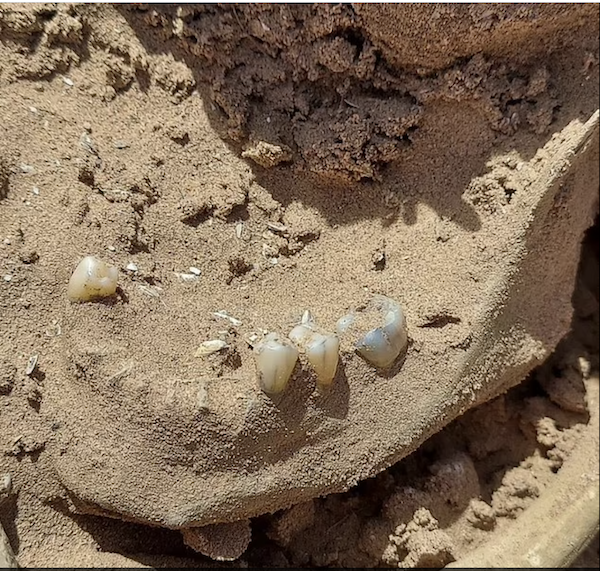
We have a name:
Thomas Erndt drowned in Lake Mead on August 2, 2002, according to the Clark County Coroner.
His remains were found at Callville Bay, located in the northwestern side of Lake Mead – the largest reservoir in the US – on May 7 and is one of the five sets of bodies found there since May 1.
Many bodies have been popping up in the lake – which is rumored to be a ‘mob-hit dumping ground’ as some of the bodies were found with gunshot wounds similar to that of mob-style – as the water level has fallen past historic lows.
I did do a search to see if either Breaking Bad or Better Call Saul had a body-dumping episode, but apparently not. We do, however, have a very Vegas lawyer:

Dinosaur Footprints (Dinosaur Valley State Park, Texas)
From Glen Mills of Texas Parks and Wildlife, dinosaur tracks. Big ones:
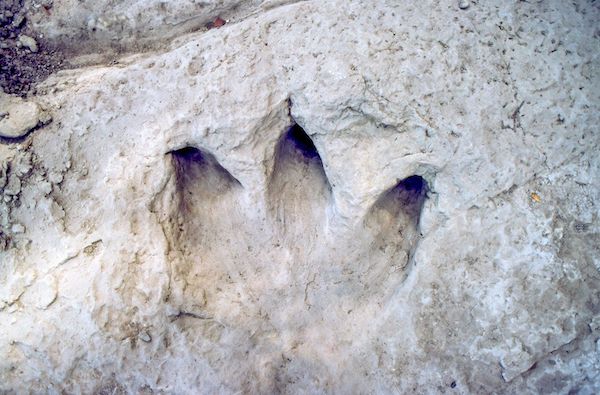
The Wall Street Journal writes:
When the waters of a Texas river receded this month, they unveiled a secret from 113 million years ago: a trail of dinosaur footprints.
The tracks in the Paluxy River weren’t just from any dinosaur, but a giant among giants. An Acrocanthosaurus—a 15-foot-tall, seven-ton beast—left behind prints that would dwarf a human foot, the Texas Parks and Wildlife Department said Wednesday.
Officials discovered the tracks earlier this month at the Dinosaur Valley State Park in Somervell County, which is about 40 miles southwest of Fort Worth. The park is known for its cache of footprints that dinosaurs had made at the edge of an ancient ocean.
No one knew about this set of Acrocanthosaurus footprints until a severe drought desiccated the Paluxy River, which runs through the park, said Stephanie Salinas Garcia, a spokeswoman for the state parks and wildlife department.
“The river dried up completely in most locations, allowing for more tracks to be uncovered here in the park,” she said. They had been shrouded before in mud and sediment, which helped preserve them from natural weathering and erosion, she added.
So the footprints are excellent and sharp, making some paleontologist happy.
Ghost Gardens (Lydiard Park, England)
From the the Friends of Lydiard Park, gardening
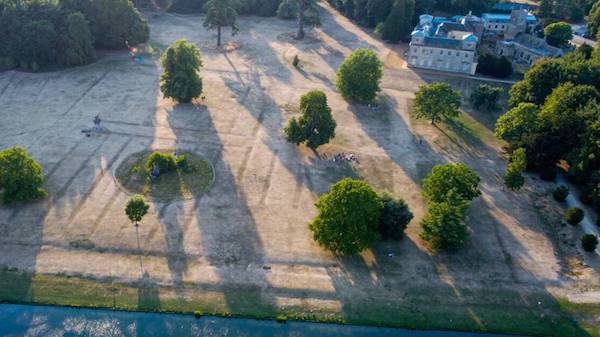
The Miami Herald writes:
The expansive lawns of grand estates across England have shriveled under the summer’s heatwave and drought, revealing remnants of long-lost gardens, according to caretakers.
Time turned backward on the sunbaked lawn of Chatsworth House — a royal estate about 150 miles northwest of London. The parched ground revealed a “lost” 17th century garden usually “hidden from view”…
Drone footage showed the lawn with wide swaths of scorched Earth forming a cross around a central fountain. At one end, dramatic curves look like waves. In other portions, the ground shows intricate, swirling fleur-de-lis-shaped patterns.
These were a European-style garden with “ornamental arrangement of flower beds and paths” in 1699, the estate explained. But the garden went out of fashion. Around 1730, the grass of a new design covered the landscape features, hiding them from visitors for the next nearly 300 years, the estate said.
A 300-year-old lawn gets its comeuppance [snarl]. So there’s a bright side.
German Battleships (The Danube, Prahovo, Serbia)
From Twitter account @khalediskef:
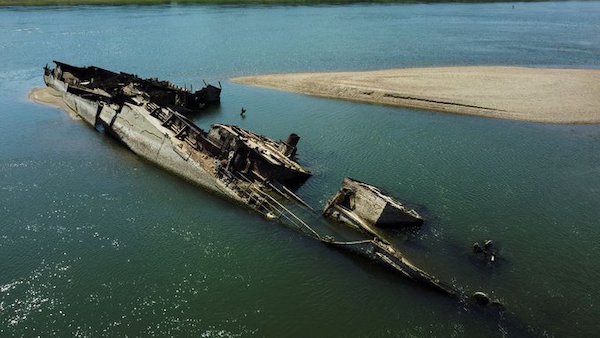
At present, Europe is recording high temperatures and is also facing the risk of drought in the entire region. The drought has revealed several findings, however. In a recent finding, more than 20 German warships that were sunk during World War II have re-emerged in the Danube River in Serbia. The warships still contain ammunition and explosives and are stretched along the river near Prahovo, Serbia’s river port town.
According to media reports, the Danube’s water level had hit its lowest level in almost a century. Ships that were discovered belonged to Nazi Germany’s Black Sea Fleet. They retreated from advancing Soviet forces in 1944. These battle warships affect river traffic whose main arteries run via Germany, Italy and France when the water level drops.
Speaking of the return of the repressed….
Hunger Stones (The Elbe, Germany and Czechia)
Wikipedia explains the concept:
A hunger stone (German: Hungerstein) is a type of hydrological landmark common in Central Europe. Hunger stones serve as famine memorials and warnings and were erected in Germany and in ethnic German settlements throughout Europe in the 15th through 19th centuries.
These stones were embedded into a river during droughts to mark the water level as a warning to future generations that they will have to endure famine-related hardships if the water sinks to this level again.
(I like the concept of hydrological landmarks, and I wonder if any readers have spotted any[4].
Via Dr. Bernd Gross:
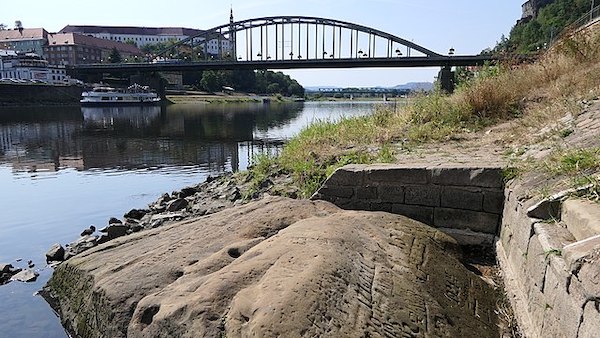
The concept of hunger stones was brought to wider attention in the 19th century by newspapers and travelogues, the mass media of the time. In 1904, the Děčín stone became the target of daily tourist excursions, and had to be protected from destruction by a wall built around it. Thousands of postcards showing the stone were sent from the town all over the world. In the 1930s, an inscription in Czech was added, reading: “Girl, don’t cry and moan when it’s dry, water the fields instead.”
As the top map shows [see the link], the hunger stones are a phenomenon with a very limited geographic scope. More than two dozen hunger stones can be found in the Elbe, with a particular concentration on the stretch on either side of the German-Czech border.
Stone Buddhas (The Yangtze, Chongqing, China)
Via Twitter account @stevievzh:
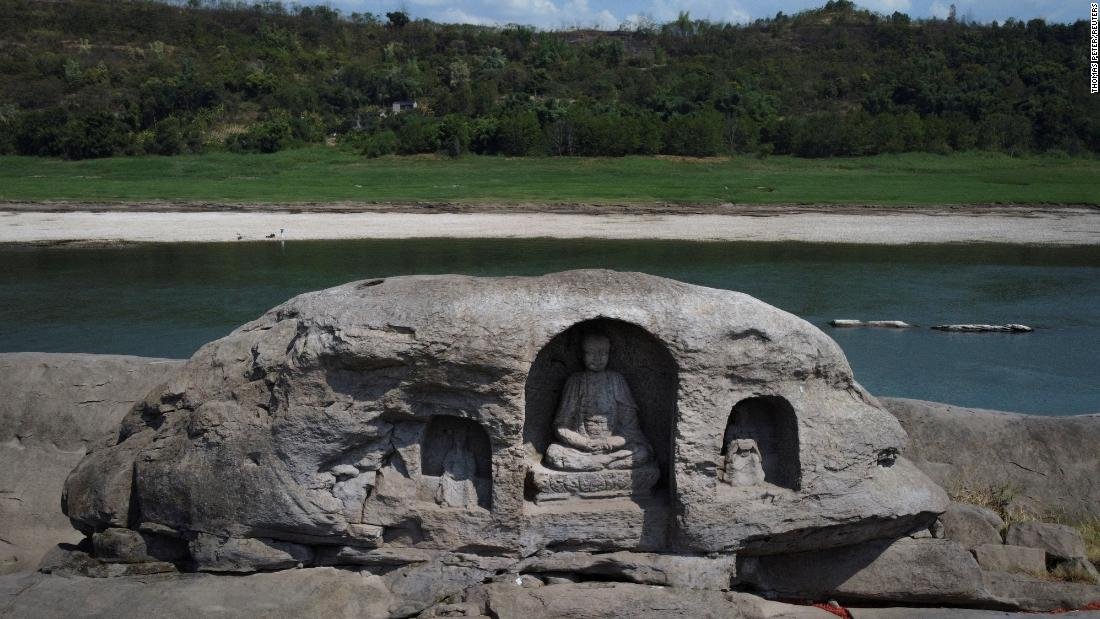
NBC writes:
The Yangtze, Asia’s largest river and a crucial part of China’s economy, has seen its water levels fall rapidly amid a drought and record-breaking heat wave.
This has revealed three ancient Buddhist statues atop a normally submerged island in the Chongqing area in the country’s southwest.
The relics feature three monk-like figures sitting and watching over the river that are believed to be about 600 years old and built during the Ming dynasty, which ruled China from 1368 to 1644.
Spanish Stonehenge (Valdecanas reservoir, Guadalperal, Spain)
Via Al Mayadeen:
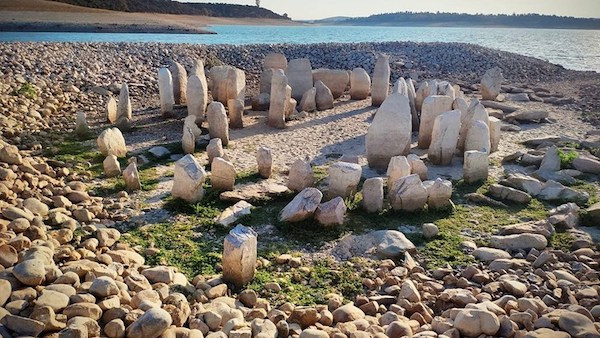
Severe droughts in Europe have caused alarm among its residents, but an unexpected side effect of the country’s worst drought in decades has brought delight to archaeologists as the emergence of a prehistoric stone circle is discovered in a dam whose waterline has receded.
Known as the Dolmen of Guadalperal but dubbed the Spanish Stonehenge, the circle of dozens of megalithic stones is believed to date back to between 4,000 to 7,000 years ago.
The Dolmen structures were discovered by German archaeologist Hugo Obermaier in 1926, but the area was later flooded in 1963 in a rural development project under Francisco Franco’s dictatorship. It currently sits in one corner of the Valdecanas reservoir, located in the central province of Caceres, where authorities recorded water levels dropping to 28% capacity.
Archaeologist Enrique Cedillo from Madrid’s Complutense University, one of the experts racing to study the circle in fear of it getting submerged again, commented, “It’s a surprise, it’s a rare opportunity to be able to access it.”
Optimistic experts!
The City of Zakhiku (Mosul Dam reservoir, Kurdistan, Iraq)
From the Universities of Freiburg and Tübingen:
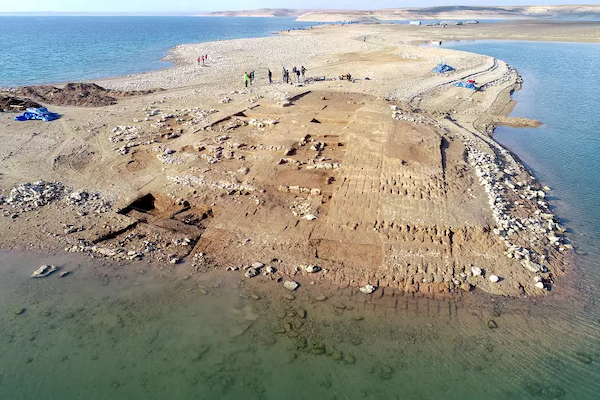
Earlier this year, the remains of a 3,400-year-old city emerged from a reservoir in Iraq after months of extreme drought.
German and Kurdish archaeologists uncovered the ancient settlement from the Mittani Empire when water levels fell rapidly. It was once located on the banks of the Tigris River and is believed to have been the city of Zakhiku, an important centre for the Mittani Empire which lasted from around 1550 to 1350 BC.
Researchers were shocked to discover well-preserved walls made from sun-dried mud bricks. Some had been underwater for 40 years since the Mosul Dam was built and the reservoir created.
They attribute this surprising preservation to an earthquake that destroyed the city in 1350 BC when the upper parts of the walls collapsed, burying the buildings completely.
(Other submerged cities along the Tigris and the Euphrates here.)
Conclusion
As a former humanities major and, well, dabbler in proscribed substances, the image of the drowned city, revealed, resonates the most with me. The drowned city most familiar to readers may be H.P. Lovecraft’s R’lyeh:
The nightmare corpse-city of R’lyeh…was built in measureless eons behind history by the vast, loathsome shapes that seeped down from the dark stars. There lay great Cthulhu and his hordes, hidden in green slimy vaults.
(Whatever it was that “seeped” down from the “dark stars” reminds me of petroleum — “slimy” and filling the “vaults” of carbon-profiteering death-eaters.) Poe, also, has his poem, The City in the Sea[5].
By whatever workings of the collective workings of our “deep well of unconscious cerebration“, the drowned cities of both Poe and Lovecraft align neatly with the drowned cities of Romantic poets — and opium addicts — Thomas DeQuincy and Samuel Taylor Coleridge:
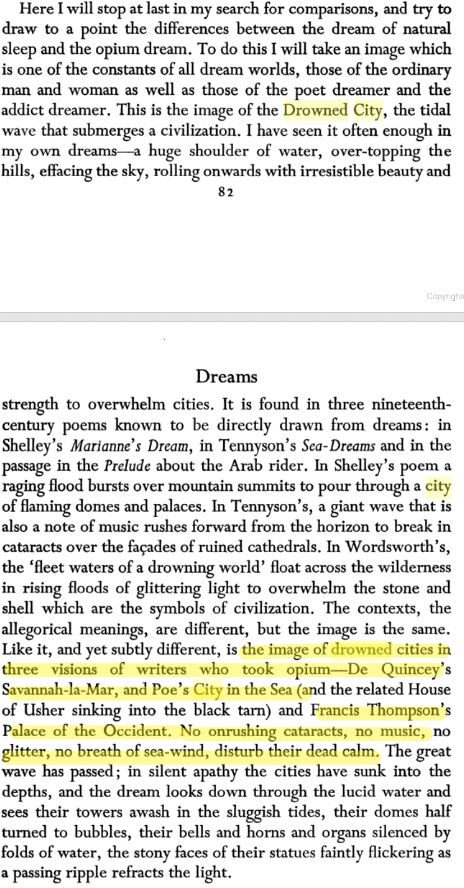
The “dead calm” and “apathy” of the Romantic drowned city is, of course, the Romantic poets’ objective correlative to the realities (and losses) of addiction. We might, then — I think I foreshadowed some far-fetching? — compare the Romantic opium addict’s “silent apathy” to our own subservience to another substance addictive, albeit socially: oil.
But what happen when the drowned city — or skull, or dinosaur track, or garden, or Nazi battleship, or hunger stone, or Buddha — is revealed?
Perhaps what happens at any “reveal,” a TV term I have taken my own sweet time getting to. From the obsessive and wonderful TV tropes, the reveal of the reveal:
The pivot in many plotlines is the Reveal. A character is revealed as another character’s father, a god, or secret suitor or arch nemesis in disguise. More broadly, the audience is given new information which had been withheld to create suspense. The Reveal changes the nature of the plot, often pushing it from suspense towards action. A good reveal will also create a new set of questions and further suspense…. Aristotle referred to it as anagnorisis (generally translated as “discovery” or “recognition”) in his Poetics, making this one Older Than Feudalism.
Generally, the “moment of discovery” for Greek dramatists was designed to evoke pity and terror in the audience. In the reveal, that which has long been repressed is made visible. But let us ask ourselves: Under neoliberalism, what is repressed? I would say everything but the lust for gain (see Rule #1).
When the waters of neoliberalism recede, what would the reveal of the reveal of the reveal be?
Possibly, skulls and Nazi battlewagons. But also mementos in the form of dinosaur footprints of how long life has persisted on this earth, in how many forms. Mementos of the human quest for order in beauty (granted, in the form of lawns). Mementos of the human quest to help the next generation survive in the form of hunger stones. Reminders of human self-organizing capacity in the form of stone circles and cities. And, of course, the Buddha.
So I don’t think the reveal of drought is all bad (reveal of the reveal of the reveal of the reveal, as it were). And if we equate — with Lovecraft? — the receding fluid that’s truly been drowning us — holding us breathless in stasis — not with water, but with oil, the net reveal may ultimately be all to the good (if we’re not collectively too stupid and have some luck). So perhaps there will be no tentacles at all when the drowned city of R’lyeh emerges. Wouldn’t that be nice?
NOTES[1] The occasion is marked by a conference in Stockholm. From what I can tell on the Twitter, masking is minimal [pounds head on desk]. I can only hope the ventilation is good.
[2] The report by the UN on which the story is based is worth reading; disaster deaths have actually gone down due to “improved early warnings and disaster management.” Of course, life expectancy in the United States had been going up for a long time, too, so perhaps this is a temporary arrangement.
[3] I confess to a liking for Japanese tsunami videos.
[4] Other “annotations”:
I’ve been mildly obsessing about our ancestors annotating the planet — hunger stones, tsunami stones, flood markers, Nilometers, etc.
Their basic message: if you’re below this line, you’re screwed.
A few links follow. Feel free to tell me what I’ve left out.
— tnielsenhayden (@tnielsenhayden) August 21, 2022
[5] From whose lines, “While from a proud tower in the town / Death looks gigantically down” the popular historian Barbara Tuchman took the title of one of her books.


